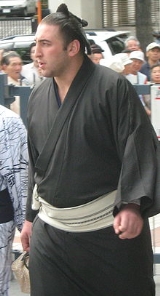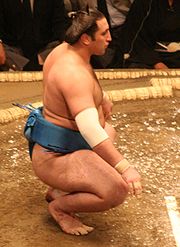
Tochinoshin Tsuyoshi
Encyclopedia
Tochinoshin Tsuyoshi is a professional sumo
wrestler from Mtskheta
, Georgia
. He is a member of the Kasugano stable
and made his debut in March 2006. He reached the top makuuchi
division just two years later in May 2008. His highest rank has been komusubi.
and sambo
. He competed in amateur sumo at the World Junior Championships in 2004, held in Osaka
, Japan
and at the World Championships in 2005. He trained at the prestigious Nichidai sumo club at Nihon University
and it was a member of that club who encouraged him to turn professional.
At the beginning of 2006 he was recruited by the former sekiwake Tochinowaka. After eleven straight kachi-koshi or winning scores he gained sekitori
status in January 2008 upon promotion to the jūryō division and immediately took the yusho
or championship in that division with a 12-3 record.
He took his first ever make-koshi or losing score in his top division debut in May 2008, but still won enough bouts to remain in the division. He reached maegashira 4 in November 2008, but facing the highest ranking men for the first time he could only record three wins against twelve losses. However, in July 2009 he produced a good score of 9-6 at maegashira 5, and was promoted to his highest ever rank of maegashira 1 in the September tournament. He could manage only four wins there, but had the best result of his career to date in November, finishing runner-up to Hakuho on 12-3 and winning his first special prize
, Fighting Spirit. However, his defeat to Hokutoriki on the final day cost him a chance of making his debut in the titled sanyaku ranks in January 2010.
In the May 2010 tournament he defeated four ozeki in a row from Days 2 to 5 (becoming only the second man below sekiwake to achieve this, following Masurao in March 1987) and won his second Fighting Spirit prize (shared with Aran
). He was rewarded with promotion to komusubi for the first time in the July 2010 tournament. He fell short with a 6-9 record, but returned to komusubi in November.
In May 2011 he equalled his best ever top division performance, once again finishing runner-up to Hakuho on 12-3 and winning another Fighting Spirit prize. This saw him return to the komusubi rank for the July 2011 tournament. His poor performance in November, scoring only 2-13, could be attributed to the fact that he was banned from training before the tournament by his stablemaster as punishment for breaking the heya
's rules on curfew and wearing Western style clothes in public.
 He is on friendly terms with fellow countryman Kokkai
He is on friendly terms with fellow countryman Kokkai
, who helped him in his early days in Japan when he was suffering from homesickness.
is migi-yotsu, meaning he likes his right hand inside and his left hand outside his opponent's arms. His most common winning technique or kimarite
is yori kiri or force out, but he also uses his left hand grip to good effect by regularly employing uwatenage, or overarm throw.
Sumo
is a competitive full-contact sport where a wrestler attempts to force another wrestler out of a circular ring or to touch the ground with anything other than the soles of the feet. The sport originated in Japan, the only country where it is practiced professionally...
wrestler from Mtskheta
Mtskheta
Mtskheta , one of the oldest cities of the country of Georgia , is located approximately 20 kilometers north of Tbilisi at the confluence of the Aragvi and Kura rivers. The city is now the administrative centre of the Mtskheta-Mtianeti region...
, Georgia
Georgia (country)
Georgia is a sovereign state in the Caucasus region of Eurasia. Located at the crossroads of Western Asia and Eastern Europe, it is bounded to the west by the Black Sea, to the north by Russia, to the southwest by Turkey, to the south by Armenia, and to the southeast by Azerbaijan. The capital of...
. He is a member of the Kasugano stable
Kasugano stable
is a stable of sumo wrestlers, part of the Dewanoumi group of stables. As of November 2007 it had 24 wrestlers. It is currently one of the most successful stables, with five sekitori wrestlers, including the Georgian Tochinoshin and the Korean born Tochinowaka, who uses the current head coach's...
and made his debut in March 2006. He reached the top makuuchi
Makuuchi
or is the top division of professional sumo. Its size is fixed at 42 wrestlers , ordered into five ranks according to their ability as defined by their performance in previous tournaments....
division just two years later in May 2008. His highest rank has been komusubi.
Career
As a teenager he practised judoJudo
is a modern martial art and combat sport created in Japan in 1882 by Jigoro Kano. Its most prominent feature is its competitive element, where the object is to either throw or takedown one's opponent to the ground, immobilize or otherwise subdue one's opponent with a grappling maneuver, or force an...
and sambo
Sambo (martial art)
Sambo is a Russian martial art and combat sport. The word "SAMBO" is an acronym for SAMooborona Bez Oruzhiya, which literally translates as "self-defense without weapons". Sambo is relatively modern since its development began in the early 1920s by the Soviet Red Army to improve their hand to hand...
. He competed in amateur sumo at the World Junior Championships in 2004, held in Osaka
Osaka
is a city in the Kansai region of Japan's main island of Honshu, a designated city under the Local Autonomy Law, the capital city of Osaka Prefecture and also the biggest part of Keihanshin area, which is represented by three major cities of Japan, Kyoto, Osaka and Kobe...
, Japan
Japan
Japan is an island nation in East Asia. Located in the Pacific Ocean, it lies to the east of the Sea of Japan, China, North Korea, South Korea and Russia, stretching from the Sea of Okhotsk in the north to the East China Sea and Taiwan in the south...
and at the World Championships in 2005. He trained at the prestigious Nichidai sumo club at Nihon University
Nihon University
Nihon University is the largest university in Japan. Akiyoshi Yamada, the minister of justice, founded Nihon Law School in October 1889....
and it was a member of that club who encouraged him to turn professional.
At the beginning of 2006 he was recruited by the former sekiwake Tochinowaka. After eleven straight kachi-koshi or winning scores he gained sekitori
Sekitori
A sekitori is a sumo wrestler who is ranked in one of the top two professional divisions: makuuchi and juryo.Currently there are 70 rikishi in these divisions...
status in January 2008 upon promotion to the jūryō division and immediately took the yusho
Yusho
A Yūshō is a tournament championship in sumo. It is awarded in each of the six annual honbasho or official tournaments, to the wrestler who wins the most number of bouts. Yūshō are awarded in all six professional sumo divisions...
or championship in that division with a 12-3 record.
He took his first ever make-koshi or losing score in his top division debut in May 2008, but still won enough bouts to remain in the division. He reached maegashira 4 in November 2008, but facing the highest ranking men for the first time he could only record three wins against twelve losses. However, in July 2009 he produced a good score of 9-6 at maegashira 5, and was promoted to his highest ever rank of maegashira 1 in the September tournament. He could manage only four wins there, but had the best result of his career to date in November, finishing runner-up to Hakuho on 12-3 and winning his first special prize
Sansho (Sumo)
Sanshō are the three special prizes awarded to top division sumo wrestlers for exceptional performance during a sumo honbasho or tournament. The prizes were first awarded in November 1947.-Criteria:...
, Fighting Spirit. However, his defeat to Hokutoriki on the final day cost him a chance of making his debut in the titled sanyaku ranks in January 2010.
In the May 2010 tournament he defeated four ozeki in a row from Days 2 to 5 (becoming only the second man below sekiwake to achieve this, following Masurao in March 1987) and won his second Fighting Spirit prize (shared with Aran
Aran Hakutora
Aran Hakutora is a Russian sumo wrestler. He began his professional career in January 2007 and made the top division in a record eleven tournaments. The highest rank he has reached is sekiwake...
). He was rewarded with promotion to komusubi for the first time in the July 2010 tournament. He fell short with a 6-9 record, but returned to komusubi in November.
In May 2011 he equalled his best ever top division performance, once again finishing runner-up to Hakuho on 12-3 and winning another Fighting Spirit prize. This saw him return to the komusubi rank for the July 2011 tournament. His poor performance in November, scoring only 2-13, could be attributed to the fact that he was banned from training before the tournament by his stablemaster as punishment for breaking the heya
Heya
In sumo wrestling, a heya , usually translated into English as stable, is an organization of sumo wrestlers where they train and live. All wrestlers in professional sumo must belong to one. There are currently 49 heya , all but four of which belong to one of five ichimon...
's rules on curfew and wearing Western style clothes in public.

Kokkai Futoshi
Kokkai Futoshi is a professional sumo wrestler from Georgia. He began his career in May 2001. He is the first Caucasian rikishi to reach sumo's highest division, makuuchi, which he achieved in 2004. His highest rank has been komusubi, which he reached in 2006...
, who helped him in his early days in Japan when he was suffering from homesickness.
Fighting style
Tochinoshin favours yotsu-sumo techniques, preferring to grapple with rather than push his opponents. His favourite grip on the mawashiMawashi
In sumo, a mawashi is the belt that the rikishi wears during training or in competition. Upper ranked professional wrestlers wear a keshō-mawashi as part of the ring entry ceremony or dohyo-iri.-Mawashi:...
is migi-yotsu, meaning he likes his right hand inside and his left hand outside his opponent's arms. His most common winning technique or kimarite
Kimarite
Kimarite are winning techniques in a sumo bout. For each bout in a Grand Sumo tournament , a sumo referee, or gyoji, will decide and announce the type of kimarite used by the winner...
is yori kiri or force out, but he also uses his left hand grip to good effect by regularly employing uwatenage, or overarm throw.

